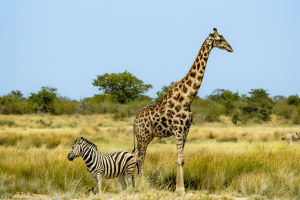Dragonflies are some of the most ancient and fascinating insects on Earth, having existed for over 300 million years.
Known for their vibrant colors and impressive flying abilities, these creatures are not just beautiful but also crucial to the ecosystems they inhabit.
With over 5,000 species of dragonflies worldwide, each with its unique characteristics and behaviors, these insects offer a glimpse into the incredible diversity of the natural world. Let's explore some of the most interesting types of dragonflies, highlighting their distinct features and ecological significance.
1. Common Green Darner (Anax junius)
The Common Green Darner is one of the most recognizable dragonfly species in North America. Named after its vibrant green thorax, this large dragonfly can grow up to 3 inches in length. Its wingspan, which can reach up to 4 inches, allows it to glide gracefully through the air.
The Green Darner is known for its incredible migratory behavior, with populations in the northern United States and Canada traveling thousands of miles to warmer regions during the fall. This species is also a voracious predator, feeding on various insects, including mosquitoes, making it a beneficial presence in many ecosystems.
2. Emperor Dragonfly (Anax imperator)
The Emperor Dragonfly, also known as the Blue Emperor, is one of the largest and most powerful dragonflies in Europe. With a wingspan of up to 4.5 inches, this species is easily identified by its bright blue abdomen and green thorax.
The Emperor Dragonfly is a skilled hunter, often seen patrolling its territory in search of prey. It primarily feeds on other insects, such as bees and butterflies, which it catches mid-flight. The Emperor Dragonfly’s ability to fly at speeds of up to 30 miles per hour makes it one of the fastest insects in the world.
3. Banded Demoiselle (Calopteryx splendens)
The Banded Demoiselle is a delicate and elegant species found across Europe and Asia. Unlike the robust build of other dragonflies, the Banded Demoiselle is more slender and has a distinctive appearance.
The males are particularly striking, with their metallic blue-green bodies and dark bands on their wings. Females, on the other hand, are usually green with transparent wings. These dragonflies are often found near slow-moving rivers and streams, where they perform intricate courtship displays. The Banded Demoiselle’s graceful flight and vibrant colors make it a favorite among nature enthusiasts and photographers.
4. Scarlet Skimmer (Crocothemis servilia)
The Scarlet Skimmer is a strikingly red dragonfly commonly found in Asia, particularly in India, Sri Lanka, and Southeast Asia. As its name suggests, the male Scarlet Skimmer is bright red, while females are usually yellowish-brown.
This species prefers stagnant or slow-moving water bodies, such as ponds, marshes, and rice fields. The Scarlet Skimmer is highly territorial, with males often seen defending their breeding sites aggressively. Despite its small size, this dragonfly is a fierce predator, feeding on various small insects, including flies and ants.
5. Black Saddlebags (Tramea lacerata)
The Black Saddlebags is a unique dragonfly species found in North America. It gets its name from the distinctive dark patches on its hind wings, which resemble saddlebags. This medium-sized dragonfly is known for its migratory behavior, similar to the Common Green Darner.
Black Saddlebags are often seen gliding high in the air, sometimes in large groups, as they migrate to warmer regions. They are also skilled hunters, preying on flying insects like mosquitoes and small moths. Their ability to hover in one spot makes them highly effective at catching prey.
6. Four-spotted Chaser (Libellula quadrimaculata)
The Four-spotted Chaser is a widespread species found in Europe, Asia, and North America. It is easily identified by the four distinctive black spots on its wings, which give it its name. This dragonfly prefers wetlands, including bogs, marshes, and ponds, where it breeds and hunts.
The Four-spotted Chaser is known for its aggressive behavior, often engaging in aerial battles with other dragonflies to defend its territory. Despite its pugnacious nature, this species plays a crucial role in controlling insect populations, particularly mosquitoes and midges.
Dragonflies are more than just beautiful insects; they are vital components of their ecosystems. Whether it’s the migratory journeys of the Common Green Darner, the swift hunting prowess of the Emperor Dragonfly, or the territorial displays of the Scarlet Skimmer, each species offers a unique glimpse into the natural world. Understanding and appreciating the diversity of dragonflies not only enhances our knowledge of these fascinating creatures but also underscores the importance of conserving their habitats to ensure their survival for generations to come.


